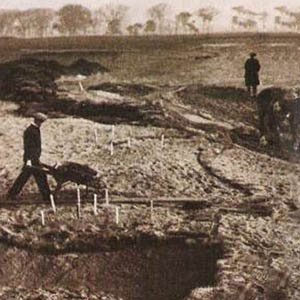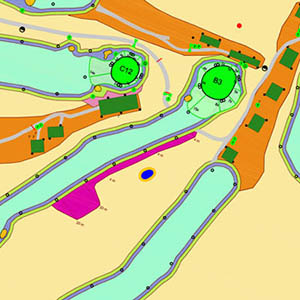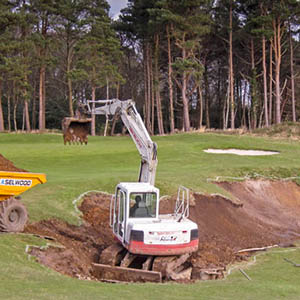Building New Courses
Infinite Variety Golf Design has significant expertise in creating original links and heathland style courses on high quality sandy sites. We follow a very structured and detailed approach to our designs, which delivers consistent, high quality. Our process begins with a thorough analysis of the proposed site. We then continue with a number of design stages which handle more and more detail as they progress. This culminates in a very hands on approach during the construction phase.
Below are detailed the individual steps undertaken in order to deliver this methodology.

1. Site Analysis
A site analysis is a very important step before deciding to seriously continue the development of a new golf course. Ideally the golf architect spends a number of days walking the site, to internalize the landscape and investigate the possible green and hole locations.
Furthermore the soil type needs to be analysed, the flora and fauna need to be recorded, and the site should be photographed extensively and if possible the site is surveyed. These elements together yield the basis of an analysis of the suitability of a site from a golf technical point of view.

2. Routing
The routing is one of the most important phases in the design of a golf course; one could argue that the routing is the skeleton of a golf course. A good routing flows from hole to hole, is varied, interesting and last but not least safe.
When making a routing a number of boundary conditions are taken into account: where the sun rises and sets, what the predominant wind direction is, if the length and directions of the holes are varied enough, if the dog-leg directions are balanced, if the walking distances between holes aren't too big, if all types of golfers use all clubs in their bag and if the holes follow the landscape.
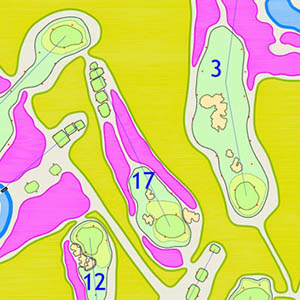
3. Master Plan
After a final routing has been chosen, a detailed design is made per hole, in which the strategy, the visual style, the greens, tees and bunkers, the mowing patterns and rough, the drainage, the planting schemes and the water areas are indicated per hole.
It is crucial that the resulting Masterplan looks good and communicates well what the idea is behind the design of the golf course; in the end this is the plan that needs to be sold to all parties involved. This was no different in the days of the classic architects such as Colt, Simpson and MacKenzie; they also spent a lot of time on the creation of a Master plan.

4. Detailed Design
In this phase all the drawings are created that are necessary to actually build the golf course, in particular the detailed contour plans for the finished grade of the holes.
These drawings form the basis for the next step in which the quantities of earth moving are calculated, but also are the basis for the contractors/shapers when they use GPS systems to build the golf course.
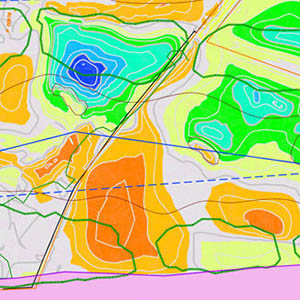
5. Quantities
Once the golf course surface contours have been drawn the next stage is to calculate the amount of soil that will need to be moved to create the finished product.
This information is shown on so called "cut and fill" drawings, that indicate where material is removed on site and where it is added. This information is crucial for the contractors to form cost estimates for the construction process.

6. Green Design
The next stage is to create detailed drawings for the greens. These generally are drawn with 5 or 10 cm contours.
The greens can be built exactly to these drawings, or the drawings can be used as a first iteration point to be roughed in with GPS, after which the green shapes are further sculpted and refined. Our preference lies with the last method because we believe that generates the most natural greens shapes.
Sometimes no green drawings are made. This is the case on sites where the natural contours are interesting enough to build a green on.
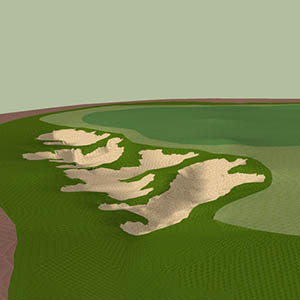
7. Visualisation
Our experience is that many clients find it diffcult to get a visual feel for how the finsihed green, hole or complete golf course will look like just based on detailed contour drawings.
To allow for a better visualisation at IVGD we increasingly have started using 3D visualisations to show how our work will look after completion.
This has become easier with the advent of stronger computing power and user-friendlier software. Possible applications are fly throughs, shade analysis for different seasons and even stroke savers.

8. Construction
The detailing of a golf course can only be great if the golf architect spends a significant amount of time on the construction site working with the team of shapers. Only by doing this the architect make sure that the detailing of the greens, bunkers and other golf course elements are exactly as he had envisioned them. This also avoids costly reworking of finished elements.
As Harry Colt once said "Making a golf course is more like painting a picture than building a road". Keeping this in mind, at IVGD we make sure we spend as much of the construction time on site as we can.

9. Ecological Design
Most golfers know that playing golf in a natural environment is more fun. However, few nature enthusiasts realise that a course can make a valuable contribution to the development new eco-systems and environmental habitats. A well designed course, where nature is a key element, can make a large economic contribution to an area whilst also delivering a large ecological contribution to the development of new nature.
IVGD works closely with Europe's foremost ecological nature developers, such as John Nicholson, STRI, Buiting Advice and NL Advisers.

